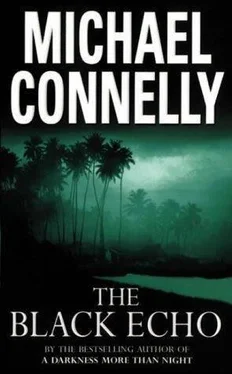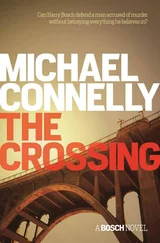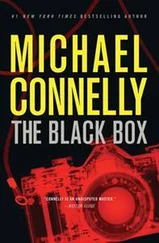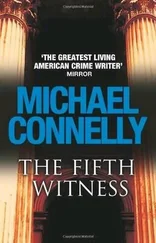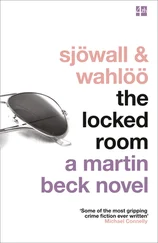“Three thousand square feet of vault space,” said Orozco, indicating the vault area with his hand. “Small private boxes along the sides and free-standing closets down the middle. If they are under there, they could come up through the floor anywhere along these two aisles. So we are talking about a range of about sixty feet in which they could come through the floor.”
“Now, Captain,” Rourke said, “if you pick that up and we look back at the DWP chart, we can place that breakthrough zone right here.” With a Day-Glo yellow underliner he outlined the floor of the vault on the utility map. “Using that as a guide, we can see the subterranean structures that offer the closest proximity. What do you think, Mr. Gearson?”
Gearson leaned over the car hood another few inches and studied the utility map. Bosch also leaned in. He saw thick lines he assumed indicated major east-west drainage lines. The kind the tunnelers would seek. He noticed that they corresponded to major surface streets: Wilshire, Olympic, Pico. Gearson pointed out the Wilshire line, saying it ran thirty feet below ground and was large enough to drive a truck through. With his finger, the DWP man traced the Wilshire line east ten blocks to Robertson, a major north-south stormwater line. From that intersection, he said, it was just a mile south to an open drainage culvert that ran alongside the Santa Monica Freeway. The opening at the culvert was as big as a garage door and blocked only by a gate with a padlock on it.
“I’d say that’s where they could’ve come in,” Gearson said. “Like following surface streets. You take the Robertson line up to Wilshire. Take a left and you’re practically here by your yellow line. The vault. But I don’t think they’d dig a tunnel off the Wilshire line.”
“No?” Rourke said. “How so?”
“Too busy is how so,” Gearson said, sensing he was the man with the answers as nine faces peered at him from around the car hood. “We got DWP people underground all the time in these main lines. Checking for cracks, blockages, problems of any sort. And Wilshire’s the main drag down there, east and west. Just like up top. If somebody knocked a hole in the wall it’d get noticed. See?”
“What if they were able to conceal the hole?”
“You’re talking about like they did a year or so ago in that burglary downtown. Yeah, that might work again, maybe somewhere else, but there is a good chance on the Wilshire line that it’d be seen. We look for that sort of thing now. And, like I said, there’s a lot of traffic on the Wilshire line.”
There was silence as they took time to consider this. The engines of the cars ticked away the heat.
“Then where would they dig, Mr. Gearson, to get into this vault?” Rourke finally said.
“We got all manner of linkups down there. Don’t think us guys don’t think of this from time to time when we’re working down there. You know, the perfect crime and all that. I’ve hashed stuff like this around, especially when I read about that last one in the papers. I think if you are saying that’s the vault they want to get into, then they’d still do just like I said: come up Robertson and then over on the Wilshire line. But then I think they’d move down one of the service tunnels to sort of stay out of sight. The service tunnels are three to five feet wide. They’re round. Plenty of room to work and move equipment. They hook up the main artery lines to the street storm drains and the utility systems in the buildings along here.”
He put his hand back into the light and traced the smaller lines he was talking about on the DWP map.
“If they did this right,” he said, “what they did was get in the gate down by the freeway and drive their equipment and all up to Wilshire and then over to your target area. They unload their stuff, hide it in one of these service tunnels, as we call ’em, and then take their vehicle back out. They hike back in on foot and set to work in the service tunnel. Hell, they could be working in there five, six weeks before we might have occasion to go up that particular line.”
Bosch still thought it sounded too simple.
“What about these other storm lines?” he asked, indicating Olympic and Pico on the map. There was a crosshatch pattern of the smaller service tunnels running from these lines north toward the vault. “What about using one of these and coming up behind the vault?”
Gearson scratched his bottom lip with a finger and said, “That’s fine. There’s that too. But the thing is, these lines aren’t going to get you as close to the vault as these Wilshire offshoots. See what I mean? Why would they dig a hundred-yard tunnel when they could dig a hundred-footer here?”
Gearson liked holding court, the idea of knowing more than the silk suits and uniforms around him. Having finished his speech, he rocked back on his heels, a satisfied look on his face. Bosch knew the man was probably correct on every detail.
“What about earth displacement?” Bosch asked him. “These guys are digging a tunnel through dirt and rock, concrete. Where do they get rid of it? How?”
“Bosch, Mr. Gearson is not a detective,” Rourke said. “I doubt that he knows every nuance of-”
“Easy,” Gearson said. “The floors of the main lines like Wilshire and Robertson are graded three degrees to center. There is always water running down the center, even most days during a drought. It might not be raining up top but water flows, you know. You’d be surprised how much. Either it’s runoff from the reservoirs or commercial use or both. Your fire department gets a call, where you think the water goes when they are done puttin’ the fire out? So what I am saying is, if they had enough water they could use it to move the displaced earth or whatever you want to call it.”
“It’s got to be tons.” Hanlon spoke for the first time.
“But it’s not several tons at once. You said they took days to dig this. You spread it out over days and the runoff could handle it. Now, if they are in one of the service tunnels they’d have to figure a way to get water through there, down to your main line. I’d check your fire hydrants in the area. You got one leaking or had a report of somebody opening one up, that’d be your boys.”
One of the uniforms leaned to Orozco’s ear and said something. Orozco leaned over the hood and raised his finger above the map. Then he poked it down on a blue line. “We had a hydrant vandalized here two nights ago.”
“Somebody opened it up,” the uniform who had whispered to the captain said, “and used a bolt cutter to cut the chain that holds the cap. They took the cap with them, and it took the fire department an hour to get out here with a replacement.”
“That would be a lot of water,” Gearson said. “That would have taken care of some of your earth displacement.”
He looked at Bosch and smiled. And Bosch smiled back. He liked when pieces of the puzzle began to fit.
“Before that, let’s see, Saturday night it was, we had an arson,” Orozco said. “A little boutique in behind the Stock Building off Rincon.”
Gearson looked at the spot Orozco pointed to on the blueprint as being the location of the boutique. He put his own finger on the fire hydrant location. “The water from both of those things would have gone into three street catches, here, here and here,” he said, moving his hand deftly over the gray paper. “These two drain to this line. The other drains here.”
The investigators looked at the two drainage lines. One ran parallel to Wilshire, behind the J. C. Stock Building. The other ran perpendicular to Wilshire, a straight offshoot, and next to the building.
“Either one and we’re still looking at, what, a hundred-foot tunnel?” Wish said.
Читать дальше
